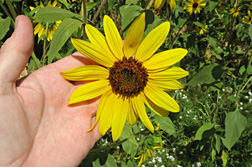This page has been archived and is being provided for reference purposes only. The page is no longer being updated, and therefore, links on the page may be invalid.
|
Read the magazine story to find out more. |
|
|
|
|
U.S. Sunflowers Could "Get a Lift" from Down Under
By Jan SuszkiwMay 13, 2008
Improved disease resistance could be in store for tomorrow's sunflower hybrids, thanks to plants that Agricultural Research Service (ARS) scientists collected in Australia last year and are now evaluating in greenhouse trials in Fargo, N.D.
ARS plant pathologist Tom Gulya and botanist Gerald Seiler traveled to Australia in early 2007 in hopes of identifying new genes that could be incorporated into American sunflower hybrids for improved resistance to fungal diseases including downy mildew, rust and Sclerotinia stalk rot.
Gulya considers stalk rot enough of an economic threat to the U.S. sunflower crop that incorporating even partial resistance from the Aussie plants would be worthwhile. He and Seiler, who are both in the ARS Sunflower Research Unit at Fargo, made the trip with funding from the ARS Plant Exchange Office. With the assistance of a team from the Department of Primary Industries and Fisheries (DPIF) in Queensland, Australia, Gulya and Seiler collected 59 populations of the wild sunflower species Helianthus annuus and H. debilis.
In the fall of 2007, they began greenhouse trials to evaluate the plants' fungal disease resistance, as well as to analyze their seed oil content and fatty acid composition. A University of British Columbia collaborator will compare the plants' genetic profiles to those of American wild sunflowers. This could reveal whether the Aussie sunflowers have undergone significant genetic changes since arriving in the Land Down Under more than 100 years ago from America.
Gulya and Seiler estimate their sunflower expedition took them on a journey of more than 6,200 miles through Western Australia, South Australia, New South Wales, Victoria and Queensland. On average, they and the DPIF team gathered 6,000 sunflower seeds per collection. This included plants from yards, hedgerows, municipal garbage dumps and other sites.
Read more about the research in the May/June 2008 issue of Agricultural Research magazine.
ARS is the U.S. Department of Agriculture's chief scientific research agency.

